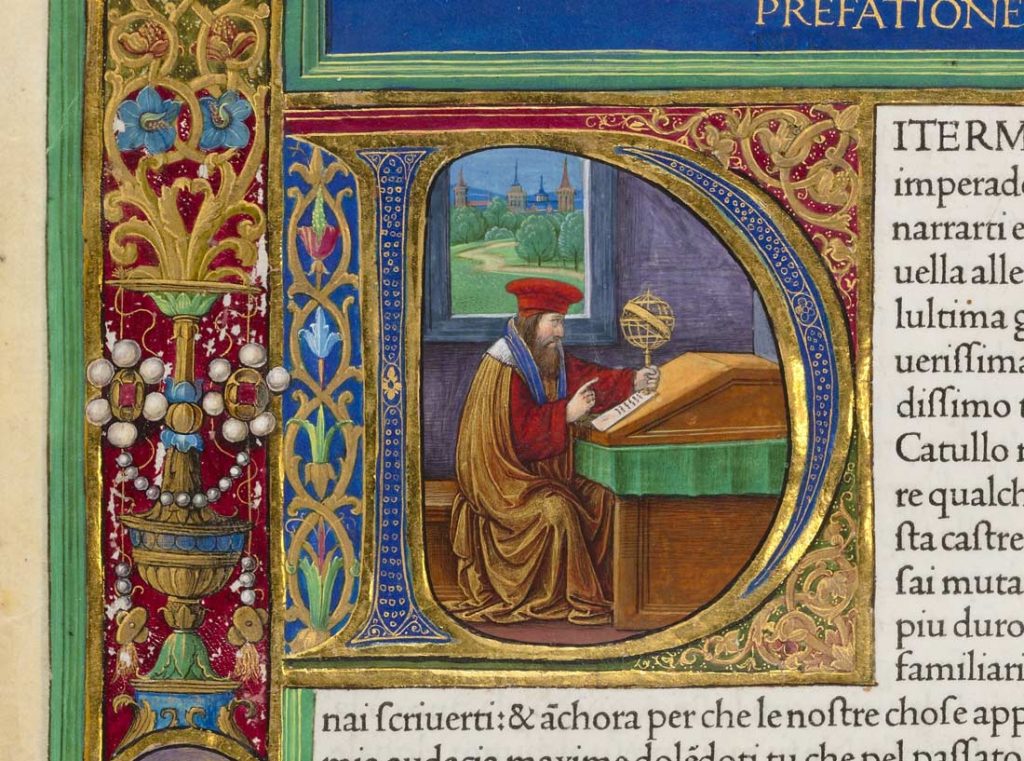Decorated Initials were created for the use of decorating medieval manuscripts. They are large letters placed at the beginning of a sentence, followed by smaller letters (diminuendo) to help readers find their place in a manuscript. Illuminated manuscripts are hand-written books that were mass-produced in the Middle Ages. Decorated initials were popularly used during the years 1100 and 1600s, though nowadays they aren’t as commonly seen in books. Illuminated manuscripts were made from animal skins with layered gold or silver leaves on top, and these decorated initials were painted on by hand using watercolours. Later on, as typography began to develop, Johannes Gutenberg popularized the mechanical movable-type printing press; this revolutionary invention helped produce books at a much faster rate! Gutenberg intentionally left space in his books for a scribe or miniature painter to paint in decorated initials.
Decorated Initials come in many forms: Historiated, Dropped and Raised Initial, Zoomorphic, Foliate, and various more. I find Decorated initials to be the best part of learning about typography because of the creativity and innovation used to make reading more visually pleasing.
Types of Decorated Initials:
Historiated & Inhabited Initial


Historiated Initials only encompass pictures, while inhabited initials contain pictures of humans or animals inside of them. They first appeared in the 8th century in English manuscripts and have been significant in typography ever since. These specialized initials were found in luxurious illuminated manuscripts (hence why they were decorated with gold and silver leaves). Historiated Initials were used as a point of reference, marking the division of the text, chapters, paragraphs, and sometimes verses.
Foliate Initial

A Foliate Initial is a plant-like decorated initial. These designs have leaves, flowers, vines, or fruits, surrounding or made out of a letter. The floral borders for foliate initials contain plants, animals, humans, and insects.
Zoomorphic initial

Zoomorphic Initials are my favourite kind of initial. Zoomorphic Initials use animals to create letters, and I’m very intrigued by this style because of the creativity used to form animals and creatures into letter shapes. The dragon in the image above was perfectly used; because of its ability to curve its body to naturally mend itself into an “S” shape without looking awkward. In general, Zoomorphic Initials catch the eyes, which would be helpful for readers to keep engaged in these books.
Sources:
https://www.flickr.com/photos/renzodionigi/3414963770/in/photostream/https://ilovetypography.com/2020/08/20/history-of-illuminated-initials/https://www.nga.gov/conservation/paper/manuscript-project.html
https://en.wikipedia.org/wiki/Illuminated_manuscript
https://en.wikipedia.org/wiki/Initial
https://en.wikipedia.org/wiki/Historiated_initial
https://www.bl.uk/catalogues/illuminatedmanuscripts/ILLUMIN.ASP?Size=mid&IllID=35978
Writing comment from Patrick
Most illuminating! Love the headline. Was expecting the body to be just as playful, but was quite happy with the depth and detail in the post. Well-paced and expressed. Minor suggestion: break that first paragraph into two. Excellent effort. Yeah Makayla!